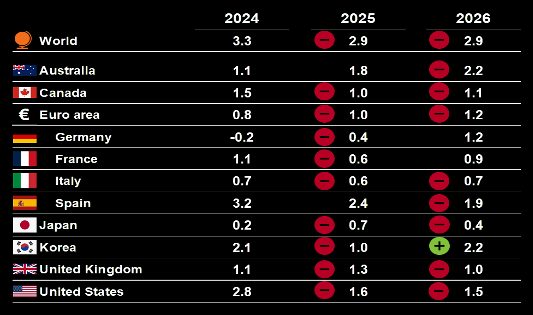Article

In early June 2025, Bank of England Governor Andrew Bailey cautioned that the trajectory of UK interest rates has become significantly more uncertain due to the ongoing impact of former U.S. President Donald Trump’s trade policies. This shift in the global economic landscape has profound implications for investors, businesses, and consumers alike. We examine the factors driving this uncertainty and its potential impact on the UK economy, providing actionable insights for stakeholders seeking to navigate a volatile monetary policy environment.
Background: UK Interest Rates and the Monetary Policy Committee
As of June 2025, the Bank of England’s (BoE) base rate stands at 4.25%, following four quarter-point cuts since summer 2024. These reductions were implemented to cushion the UK economy against weakening growth and to address slowing wage pressures. However, the pace and magnitude of future cuts remain unclear. The Monetary Policy Committee (MPC) is divided on the appropriate path forward, reflecting divergent views on inflationary risks and economic headwinds. Some members, like Swati Dhingra, advocate for larger rate reductions, whereas others, such as Catherine Mann, favour more measured cuts followed by a period of stability.
- Current Benchmark Rate: 4.25% (as of June 2025)
- Recent Policy Moves: Four successive quarter-point cuts since mid-2024
- MPC Dynamics: Split between advocates of aggressive easing and proponents of cautious, incremental cuts
Understanding the Bank of England’s (BoE) decision-making framework is critical, as interest rates influence borrowing costs for households, funding expenses for businesses, and yield curves for fixed-income investors. When the MPC debates future cuts, it weighs inflation forecasts, wage growth trends, and external shocks—most recently, those stemming from disruptions in U.S. trade policy.
The Disruptive Role of Trump’s Trade Policies
Tariff Volatility and Global Trade Uncertainty
Governor Bailey emphasised that Trump’s on-again, off-again tariff announcements have injected significant volatility into global trade flows, disrupting long-established supply chains and dampening business investment. Specific sectors, such as manufacturing, automotive, and technology, have experienced heightened input costs due to abrupt tariff escalations on steel, aluminium, and various Chinese imports. As a result, firms are delaying expansion plans or reallocating capital, which in turn slows productivity growth and heightens recessionary risks in open economies like the UK.
- Tariff Measures Cited: Unilateral U.S. tariffs on steel and aluminium, along with tariffs targeting Chinese goods
- Business Response: Deferred capital expenditures, supply-chain reconfiguration, and cost pass-through to consumers
This trade policy uncertainty exacerbates the forecasting difficulties faced by central banks. When forecasting inflation and output, the BoE must now model not only domestic wage and price pressures but also assess the ripple effects of transatlantic tariff disputes. These complications underpin Bailey’s warning that the future path of UK interest rates is weaker than previously assumed, contingent on the unpredictable evolution of U.S. policy.
Implications for Global Growth
Bailey’s testimony before the Treasury Select Committee highlighted the broader fallout: the dismantling of the post–World War II, rules-based trading system. The Organisation for Economic Co-operation and Development (OECD) has already downgraded its global growth forecasts for 2025 and 2026 to 2.9% due to U.S. tariff-induced policy uncertainty and waning demand in major economies, such as the U.S. and China. For the UK, an open economy with significant trade exposure, the risk of spillovers is acute.
- OECD Forecast Revision: Global growth lowered to 2.9% for 2025–2026
- Sectoral Impact: Exports to U.S. and EU markets face higher non-tariff barriers and slower demand growth
By acknowledging these headwinds, the BoE is effectively signalling to markets that conventional monetary easing assumptions may not be sufficient to counteract externally driven shocks. In turn, this messaging could sustain elevated volatility in gilt yields, sterling exchange rates, and equity market valuations until U.S. trade policy stabilises.

Implications for the UK Economy
Cost of Borrowing and Mortgage Markets
A central bank that signals uncertainty about future rate cuts often sees immediate reactions in mortgage pricing. Many lenders price variable-rate and tracker mortgages off the Bank of England’s base rate, meaning that any suggestion of delayed cuts may push rates on home loans higher than previously anticipated. Although the BoE has already cut rates to 4.25%, lingering uncertainty could stall a further descent towards sub-4% territory. For new homebuyers and those looking to remortgage:
- Short-Term Outlook: Rates may stay near 4.25% for longer if external shocks intensify
- Refinancing Strategies: Fixed-rate deals at historically low levels (3.5%–4.0%) could become more sought-after as borrowers hedge against future volatility
De Pointe Research recommends that prospective homebuyers closely monitor two-year and five-year fixed mortgage offerings, as these products often incorporate market expectations of the Bank of England’s (BoE) moves. If the Bank signals further cuts at an upcoming MPC meeting, borrowing costs could edge down. Conversely, if Trump-related shocks persist, lenders may raise risk premiums, which would flatten the yield curve and keep mortgage rates elevated.
Business Investment and Corporate Financing
Business investment in the UK has already begun to show signs of cooling due to geopolitical uncertainty. Firms dependent on imported intermediate goods face fluctuating input prices, which reduces profit margins and discourages capital expenditure. With the BoE divided on the magnitude of future rate cuts, companies may hesitate to lock in long-term financing until the policy trajectory becomes more transparent. Key takeaways for corporate planning include:
- Working Capital Management: Hedge currency exposure to the U.S. dollar shifts since a stronger dollar (on trade tensions) makes imports costlier.
- Capital Raising: Consider issuing debt now if covenants and yields on corporate bonds remain favourable to preempt higher borrowing costs later.
- M&A Considerations: Lower interest rates typically spur merger and acquisition activity, but persistent uncertainty could delay deal-making until market signals clarify.
By focusing on balance-sheet resilience and maintaining flexible financing structures, businesses can insulate themselves from sudden policy reversals and tariff escalations.
Inflation and Wage Growth Dynamics
Governor Bailey noted that UK wage growth is expected to slow in the coming months, which—if realised—would allow the BoE to cut rates further. Slowing wage growth reduces domestic inflationary pressures, thereby providing the BoE with room to ease monetary policy. However, differing forecasts among MPC members complicate this outlook:
- Swati Dhingra’s View: Emphasises potential for significant headwinds, advocating for larger rate cuts to support growth.
- Catherine Mann’s View: Prefers a decisive cut followed by stability to avoid fueling a resurgence in inflation later.
De Pointe Research forecasts that if wage growth decelerates to around 3.0% by Q3 2025 (from ~3.5% in Q2), core inflation could drop below the BoE’s 2% target by early 2026. In this scenario, the MPC would likely implement two further quarter-point cuts—potentially bringing the base rate to 3.75% by year-end. Conversely, if wages remain elevated above 3.5%, rate cuts may be delayed or shallower.
De Pointe Research Insights and Recommendations
Navigating Interest Rate Volatility
Given the heightened uncertainty around future rate cuts, De Pointe Research advises clients to adopt a multi-faceted approach to fixed-income and currency exposures:
Bond Laddering Strategies:
Establish a ladder of gilts with staggered maturities (e.g., 2-year, 5-year, 10-year).
As shorter-dated bonds mature, reinvest proceeds depending on updated BoE guidance.
This reduces reinvestment risk if interest rates remain higher for an extended period.
Currency Hedging for International Portfolios:
With the U.S. dollar likely to appreciate amid trade tensions, consider using forward contracts or currency options to hedge U.S.-denominated assets.
A stronger dollar can erode returns on global equity holdings when converted back into sterling.
Floating-Rate Notes (FRNs):
Allocate a portion of fixed-income exposure to FRNs, which adjust coupons in line with the base rate. This mitigates duration risk in the event of unexpected rate hikes.
Equity Market Positioning
In an environment where monetary policy is data-dependent and external shocks remain a wildcard, De Pointe Research suggests a tactical overweight in defensive sectors and select cyclical names:
Defensive Sectors:
Consumer staples, healthcare, and utilities typically exhibit stable earnings during uncertain rate environments.
Dividend yields in these sectors often remain attractive when bond yields are volatile.
Cyclical Opportunities:
If further rate cuts materialise and global growth improves (e.g., a U.S.-EU tariff resolution), sectors like industrials, technology, and consumer discretionary could benefit from a lower discount rate.
Consider tilting a small portion of the portfolio toward high-quality cyclical stocks with strong balance sheets to capitalise on a rapid rebound.
Emerging Market Exposure:
Emerging markets could outperform if the U.S. dollar retreats and global trade stabilises. However, risks remain elevated; therefore, position sizing should be conservative, and currency hedges should be employed where possible.
Corporate Borrowing and Capital Structure
For corporate clients, De Pointe Research recommends stress-testing capital structures under various interest rate scenarios:
Scenario 1: Rapid Rate Cuts to 3.75% by Year-End
Refinancing opportunities at lower UK interest rates could allow companies to reduce their interest expenses.
Evaluate early repayment or restructuring of existing floating-rate debt.
Scenario 2: Prolonged Rate Plateau at 4.25%
Maintain liquidity buffers and access to committed credit lines.
Consider issuing fixed-rate debt sooner rather than later, as yields may not decline significantly.
Scenario 3: External Shock Reversal Leads to Re-tightening
If Trump-style tariffs escalate again or global growth stalls further, yields on UK gilts could spike on safe-haven flows.
Ensure debt covenants include flexibility and avoid refinancing windows during anticipated stress periods.
By preparing for downside and upside rate volatility, corporates can optimise their cost of capital and reduce refinancing risk.
The Bank of England’s recent acknowledgement that Trump’s trade policies have “shrouded” UK interest rate decisions in additional uncertainty serves as a crucial signal for all market participants. As the MPC weighs the timing and scale of future cuts, stakeholders, from homeowners locking in mortgage rates to institutional investors allocating across fixed income and equities, must navigate an environment where traditional monetary policy playbooks face unexpected headwinds. De Pointe Research emphasises the importance of diversified bond ladders, strategic hedging, selective equity exposure, and stress-tested corporate capital structures. By staying agile and closely monitoring BoE communications, clients can position themselves to capitalise on opportunities while mitigating the risks posed by ongoing global trade and monetary policy uncertainty.





